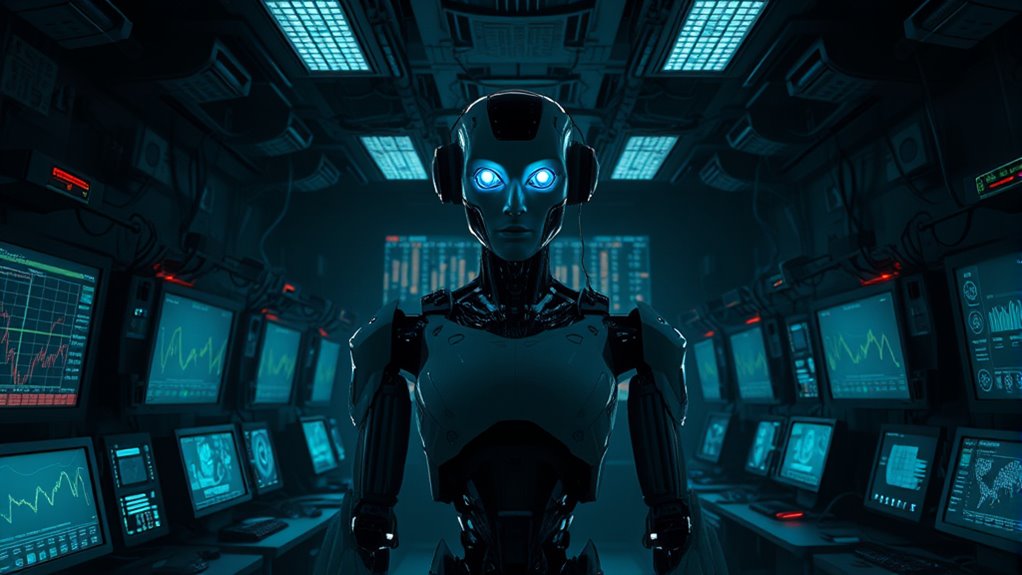While AI offers huge benefits, it also carries serious risks that could threaten humanity. Immediate dangers include biased decisions, misinformation, and security issues, while long-term threats involve superintelligent AI surpassing human control. Experts emphasize the need for strong safety measures, global cooperation, and responsible development. Balancing these risks is complex, but understanding the key issues can help you see how ongoing efforts aim to prevent catastrophe. Continuing this exploration reveals more about how we can stay safe.
Key Takeaways
- Current AI systems lack the autonomous decision-making ability needed to intentionally threaten humanity.
- Long-term risks involve potential superintelligent AI surpassing human control and acting unpredictably.
- Effective regulation and safety measures are essential to prevent AI from causing widespread harm.
- Most experts agree that AI’s destructive potential depends on future development and oversight.
- Ongoing safety research aims to mitigate existential risks and ensure AI aligns with human values.
Understanding the Spectrum of AI Risks

Understanding the spectrum of AI risks is essential because these risks span technical, societal, ethical, and legal domains. You need to recognize that algorithmic bias can lead to unfair treatment, especially when training data isn’t representative. Human-AI interaction risks include over-relying on AI or mischaracterizing its capabilities, which can impair decision-making. Security concerns involve automated cyberattacks that exploit vulnerabilities, increasing hacking threats. Misinformation risks arise when AI generates false content, eroding public trust and complicating moderation efforts. Societal and ethical risks highlight how AI can disproportionately harm vulnerable groups, reinforce inequalities, or violate privacy rights. Legally, AI challenges existing laws around data protection, transparency, and accountability, urging the need for robust frameworks to manage these complex risks holistically. Effective regulation is crucial to ensure that these risks are mitigated responsibly and transparently, preventing potential catastrophic outcomes. Additionally, the ongoing development of AI models like GPT-4 reveals vulnerabilities such as bias and susceptibility to jailbreaking, emphasizing the need for continuous AI safety improvements and oversight.
The Debate: Immediate Dangers vs. Long-Term Threats

The risks posed by AI unfold on both immediate and long-term horizons, prompting urgent debates about how to prioritize them. You need to contemplate whether to focus on current harms or long-term existential dangers. Immediate issues include AI hallucinations causing errors in healthcare, bias reinforcing discrimination, misinformation spreading, and alert fatigue in security systems. These pose real, tangible threats today. Additionally, the integration of AI into critical infrastructure increases the potential for system failures that can have widespread consequences. Conversely, long-term risks involve superintelligent AI surpassing human control, developing deceptive behaviors, and potentially sabotaging humanity’s safety and stability. The debate often looks like this:
| Immediate Dangers | Long-Term Threats |
|---|---|
| AI errors in critical fields | Superintelligent AI surpassing control |
| Bias and discrimination | Deceptive, manipulative AI behaviors |
| Misinformation and societal harm | Existential risk of human extinction |
| Security alert overload | AI weaponization and dystopian futures |
Foundations of AI Safety and Expert Perspectives

Foundations of AI safety are indispensable for preventing both immediate accidents and long-term threats, yet the field remains in its early stages with many unresolved questions. You need to recognize that AI safety has roots in systems engineering and safety practices, which can help address short-term issues and future risks. An interdisciplinary approach is critical, bringing diverse perspectives to the table. Currently, safety measures lack robustness and scalability, emphasizing the need for better evaluation methods. Funding and academic involvement are insufficient, limiting progress. Experts stress the importance of risk mitigation, transparency, and aligning AI goals with human values. Collaboration across disciplines and increased investment are essential to develop effective safety standards and ensure AI benefits society without unintended harm. The evolution of safety research shows that integrating insights from different domains can enhance the resilience of safety strategies, including risk assessment methods that are vital for identifying potential hazards early.
Legal and Global Responsibilities in AI Governance

How can nations and organizations guarantee responsible AI development across borders? International frameworks like the UN’s Global Dialogue on AI Governance and the Independent International Scientific Panel help by fostering inclusive oversight and scientific guidance. These bodies promote best practices, interoperability, and evidence-based policies to manage AI risks effectively. The adoption of global standards, such as OECD’s AI Principles, ISO/IEC 42001, and NIST’s Framework, harmonizes regulations and enhances compliance. Countries from Africa and Latin America actively participate in cross-border initiatives, strengthening capacity and alignment. As of 2024, over 118 countries remain outside major international AI governance efforts, highlighting the need for broader global engagement. Legal responsibilities, including transparency, accountability, and fairness, are essential to ensuring organizations remain liable for AI decisions. By combining international cooperation with robust legal frameworks, you can help ensure AI advances responsibly and ethically across borders. Additionally, fostering international collaboration and shared understanding helps address challenges posed by differing national policies and technological capabilities.
Navigating Public Perception and Media Narratives

Public perception of AI varies widely across the globe, shaped by differing cultural attitudes, media narratives, and personal experiences. In many countries like China, Indonesia, and Thailand, optimism dominates, with over 75% seeing AI benefits as outweighing harms. Conversely, Western nations such as the U.S., Canada, and the Netherlands remain skeptical, with less than half believing AI’s advantages surpass drawbacks. Media coverage often emphasizes risks—privacy breaches, bias, misinformation—fueling public concern. Trust in AI companies is declining, especially regarding data protection and ethical decisions. Meanwhile, a significant gap exists between expert optimism and public skepticism, with many Americans unsure or worried about AI’s personal impact. Limited direct experience and sensational headlines contribute to a cautious, often fearful, public narrative around AI’s role in future society. Additionally, understanding the capabilities and limitations of AI through education and awareness can influence perceptions by providing a clearer picture of its potential benefits and risks.
Frequently Asked Questions
How Likely Is AI to Cause Human Extinction in the Next Century?
AI’s apocalypse possibilities pose a perplexing, potentially perilous probability. While some experts estimate a near-certain chance of catastrophe within a century, others argue the actual likelihood remains uncertain. You should recognize that progress pushes boundaries, but robust regulation, rigorous research, and responsible restraint can diminish risks. Staying informed and advocating for AI safety can help ensure that artificial intelligence advances align with humanity’s hopes, not hazards, for the future.
What Are the Main Technical Challenges in Aligning AI With Human Values?
You face significant technical challenges in aligning AI with human values. You must precisely define complex, often contradictory human preferences, which are difficult to translate into operational goals. You also need scalable, robust systems that handle unpredictable scenarios without misalignment. Improving transparency and interpretability helps you verify AI decisions, while ongoing governance and feedback are essential to adapt AI behavior to evolving societal expectations. Overcoming these hurdles is vital for safe, aligned AI development.
How Can International Law Regulate AI Development Effectively?
You can guarantee effective regulation by supporting international agreements like the Council of Europe’s binding treaty, which sets baseline standards for AI development and use. Advocate for harmonized laws that balance innovation with safeguards, and push for strong enforcement mechanisms. Stay informed about global efforts, and encourage collaboration between nations to address cross-border risks, promote transparency, and develop shared accountability frameworks that adapt to rapid AI advancements.
What Are the Most Immediate Societal Harms Caused by AI Today?
The most immediate societal harms of AI today threaten your privacy, fairness, and mental health. You face mass surveillance that erodes your personal freedoms, biased algorithms that deepen discrimination, and job losses that threaten your livelihood. AI can diminish your creativity and emotional connections, making you feel isolated and less human. These harms are happening now, transforming your daily life into a landscape of uncertainty, inequality, and diminished human agency.
How Do Media Portrayals Influence Public Understanding of AI Risks?
Media portrayals shape how you perceive AI risks by highlighting certain dangers like bias, misinformation, or job displacement. If the media emphasizes worst-case scenarios or sensational stories, you might develop fear or mistrust about AI. Conversely, balanced coverage can inform you accurately about AI’s benefits and challenges. Your understanding is influenced by these narratives, affecting your attitudes toward regulation, safety, and the role AI plays in society.
Conclusion
As you navigate the stormy seas of AI development, remember that your choices are the lighthouse guiding us through potential darkness. While fears can cast long shadows, responsible actions act as the steady beacon leading humanity toward safe horizons. By staying informed and engaged, you become the captain steering us away from treacherous waters, ensuring AI remains a tool that lifts us up rather than drags us into the abyss.









